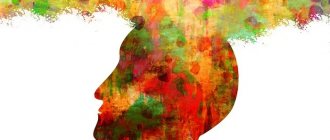What is self-awareness
Self-awareness
- this is a person’s understanding of the essence of his own personality, awareness of his place in society and the whole picture of the world. This is the vision and analysis of personal emotions, feelings and motives of behavior.
The peculiarity of self-awareness is that a person figuratively bifurcates:
- on the one hand, he is an object of knowledge for himself;
- on the other hand, consciousness acts as a subject for studying an object.
With the help of self-awareness, we see our emotions, feelings and needs, understand the motivation for our actions and what role we play in society. We recognize ourselves as a separate unit, a personality, but at the same time, embedded in the surrounding objective world.
A person can say about himself: “I am Evgeny Ivanov, I am 47 years old, I am a mechanic. I have parents, a wife and two children. My needs for a roof over my head and food are satisfied. I have friends with whom I spend time fishing and satisfy my need for communication. But I also want to have a car and play tennis, and now I’m working to achieve these goals.”
Of course, the description presented is very primitive, but it reflects the essence of the self-awareness of a person who understands his characteristic features and characteristics that distinguish him from other people.
Introduction
Human consciousness is a complex phenomenon; it is multidimensional, multidimensional. The versatility of consciousness makes it an object of study for many sciences, including psychology.
The problem of consciousness has always attracted the close attention of psychologists and philosophers, because determining the place and role of man in the world, the specifics of his relationship with the surrounding reality presupposes clarification of the nature of human consciousness.
From the point of view of psychology, consciousness acts as a special form of reflection, regulation and management of people’s attitude to the surrounding reality, to themselves and their methods of communication, which arise and develop on the basis of practically transformative activity. It not only reflects, but also creates the world. Consciousness is a social product from the very beginning. It arises and develops only in the joint activity of people in the process of their work and communication.
For philosophy, this problem is important because certain approaches to the question of the essence of consciousness, the nature of its relationship to being, affect the initial ideological and methodological guidelines of any philosophical direction. Naturally, these approaches are different, but all of them, in essence, always deal with a single problem: the analysis of consciousness as a specifically human form of regulation of human interaction with reality.
Personal self-awareness in psychology
The concept of self-awareness is so complex and multifaceted that in psychology there is still no single concept of its understanding. Synonyms for the word are: “I am a self,” “I am a concept,” “self-identity.”
The basics of the concept were formulated by S.L. Rubinstein, who pointed out the possibility of self-awareness to understand oneself, the personal environment and the existing structure of relationships with people.
According to S.V. Vygotsky, self-consciousness is formed in a person by the end of adolescence. He connects this process with the ability to reflect (think, ponder), which is formed by the age of seven.
According to the theory of V.S. Merlin's understanding of himself consists of the following components:
- Distinctive features from other subjects and objects.
- Understanding your own emotions, having self-esteem.
- Awareness of oneself as a subject of activity.
Psychologists have identified the following criteria for self-awareness:
- Isolation of the individual from the environment (material and social).
- Understanding the ability to control oneself – actions and thoughts.
- Trying on the visible qualities of other people.
- The ability to see your needs and the deep motives of your actions.
- Awareness of one’s own character traits and personality traits, both existing and desired.
In addition, within the framework of self-awareness in psychology, such a factor as attitude towards other people is highlighted; it can also be different.
The egocentric layer assumes that the individual forms an attitude towards others in accordance with their attitude towards themselves. That is, if they love me, then I love, if they respect me, then I will respect.
The group-centric stage of relationships is based on the principle: “If a person belongs to a certain group, then he is correct.” It is assumed that the person himself belongs to this same group.
A prosocial approach ensures understanding of the value of any person and acceptance of him with all his shortcomings.
At the highest, estoholic level, other people are considered as part of the spiritual world, humanity and patience are positioned in relation to any individual.
Abstract on the topic “I-Concept of Personality”
Abstract topic
“I-Concept of Personality”
Contents
1. The concept of “I” - concepts 2. Formation of “I” - concepts 3. The structure of the Self-concept 4. The role of the Self-concept in the life of an individual 5. Self-esteem as the center of personality 6. Threat Self - concepts List of sources used
1.
The concept of “ I - concepts ”
Originating in foreign psychological literature, in the last decades of the 20th century. the concept of “Self-concept” has firmly entered into everyday life in Russian psychology. However, in the literature there is no single interpretation of this concept; the closest in meaning to it is the concept of “self-awareness”.
“I-concept” is a dynamic system of a person’s ideas about himself, which includes a person’s awareness of his qualities (physical, emotional and intellectual), self-esteem, as well as subjective perception of external factors influencing a given personality.
Psychological dictionaries interpret self-concept as a dynamic system of a person’s ideas about himself. The English psychologist R. Berne, in his book “Development of the Self-Concept and Education,” defines the Self-concept as “the totality of all an individual’s ideas about himself, associated with their assessment.” The self-concept arises in a person in the process of social interaction as an inevitable and always unique result of mental development, as a relatively stable and at the same time mental acquisition subject to internal changes and fluctuations. The initial dependence of the self-concept on external influences is undeniable, but later it plays an independent role in the life of every person. The world around us and ideas about other people are perceived by us through the prism of the self-concept, which is formed in the process of socialization, but also has certain somatic, individual biological determinants.
One of the first theories describing the “I-concept” was the theory of W. James, where two sides of the “I” (Self) were identified - subjective and object. One side of the personality is the “conscious I” (I), and the second is the part that is realized - “I as an object” (Me). In the personality structure, this author identified four components and arranged them in order of importance: from lowest to highest, from physical to spiritual (Table 1).
Table
1. Idea of “ I - concept ” U. James
Component
Description
"Spiritual Self"
"Material Self"
"Social Self"
"Physical Self"
Internal and subjective existence of a person. A set of his religious, political, philosophical and moral attitudes
adjustments and improvements. Find out the cost of your work
What a person identifies with himself (his home, private property, family, friends, etc.)
Recognition and respect that a person receives in society, his social role
The human body, its primary biological needs
The final formation of ideas about the “I-concept” occurred in the 1950s in line with humanistic psychology. The example below highlights the main provisions of C. Rogers’ “I-concept”.
- “Self-concept” is the idea and inner essence of an individual, which gravitates toward values that have cultural origins.
- “I-concept” is stable and provides stable ways of human behavior.
- The self-concept has individuality and uniqueness.
- A person’s perception of the world around him is refracted by his consciousness, the center of which is the “I-concept”.
- The discrepancy between the individual’s experience and his “I-concept” is neutralized with the help of psychological defense mechanisms.
- “I-concept” is close to the concept of “self-awareness”, but rather “I-concept” is the result of self-awareness.
- “I-concept” arises as a result of mental development in the process of social interaction with the environment. The social environment (as opposed to genetic factors) plays a decisive influence on the formation of the “I-concept”, but then the “I-concept” begins to determine the way a person interacts with the social environment.
2.
Formation of the individual’s self - concept
The relationship between a person and the world is rich and diverse. In the system of these relationships, he has to act in different capacities, in different roles, and be the subject of a wide variety of activities. And from every interaction with the world of things and the world of people, a person “takes out” the image of his Self. In the process of self-analysis, the division of individual specific images of his Self into their constituent formations - external and internal psychological characteristics - there is, as it were, an internal discussion with oneself about one’s personality. Each time, as a result of self-analysis, according to S.L. Rubinstein, the image of one’s self “is included in ever new connections and, because of this, appears in ever new qualities, which are fixed in new concepts... it seems to turn the other side each time, new properties are revealed in it.”
Thus, a generalized image of one’s Self gradually emerges, which seems to be fused from many individual specific images of the Self in the course of self-perception, introspection and introspection. This generalized image of one’s self, arising from individual, situational images, contains general, characteristic features and ideas about one’s essence and is expressed in the concept of oneself, or self-concept. In contrast to situational images of the Self, the Self-concept creates in a person a feeling of his constancy and self-identity.
The self-concept formed in the process of self-knowledge at the same time is not something given once and for all, frozen; it is characterized by constant internal movement. Its maturity and adequacy are tested and corrected by practice. The self-concept significantly influences the entire structure of the psyche, worldview as a whole, and determines the main line of human behavior.
3.
The structure of the self - concept
R. Berne (like many domestic psychologists) identifies three components in the structure of the self-concept: cognitive, evaluative and behavioral. The cognitive component, or self-image, includes the individual's ideas about himself. The evaluative component, or self-esteem, includes an affective evaluation of this self-image. The behavioral component includes potential behavioral reactions or specific actions that can be caused by knowledge about oneself and attitude towards oneself. This division of the self-concept into components is arbitrary; in fact, the self-concept is a holistic formation, all components of which, although they have relative independence, are closely interconnected.
4.
The role of the I - concept in the life of the individual
“I-concept” plays an important role in the life of the individual (Fig. 2). This is primarily manifested in its following functions.
- Ensuring internal consistency of the personality. Any environmental influences are compared with the “I-concept” of the individual, and if they do not correspond to it, they are distorted or repressed using psychological defense mechanisms that protect the integrity and constancy of the “I-concept”.
- Determining the nature of the interpretation of life experience. The “I-concept” acts as an internal filter that allows information to pass through itself or delays it if it contradicts the “I-concept”.
- The source of attitudes and expectations of the individual. “Self-concept” determines the forecasts and expectations of the individual (confident or uncertain behavior, high or low self-esteem). Each of these attitudes can be realized in three aspects: physical, emotional, social (Fig. 3). For example, in the physical aspect, a woman may not be satisfied with her appearance (“Real Self”), and she will strive to change it with the help of cosmetics, approaching her ideal of beauty (“Ideal Self”), while she is quite satisfied with her social position (“Real Self”). At the same time, she may think that others consider her too cold and little emotional (“Mirror Self”).
The reality of a person’s “I-concept” is determined by the following factors:
- clarity of individual self-awareness and the presence of adequate symbols for its expression;
- a sense of personal adequacy of the individual;
- the individual’s lack of a sense of threat in a situation of self-description.
5.
Self-esteem as the center of personality
Self-esteem refers to the central formations of personality, its core. Self-esteem largely determines the social adaptation of an individual and is a regulator of behavior and activity. Although, of course, one should be aware that self-esteem is not something given, initially inherent in the individual. The formation of self-esteem itself occurs in the process of socialization, in the process of activity and interpersonal interaction. Society greatly influences the formation of an individual’s self-esteem. A person’s relationship to himself is the most recent formation in the system of a person’s relationship to the world. But, despite this (or perhaps precisely because of this), self-esteem has a particularly important place in the structure of personality relationships.
Self-esteem is directly related to the process of social adaptation and maladaptation of the individual. Despite all the inconsistency of modern data on the self-esteem of juvenile delinquents, ideas about the connection between self-esteem and antisocial and delinquent behavior of a teenager are almost universally accepted. The debate mainly boils down to clarifying the nature of the offender’s self-esteem - overestimated or underestimated. The most common position, based on empirical research, is the position that both adolescent delinquents and adult offenders have inflated self-esteem. In this regard, it is noted that inadequate, inflated self-esteem associated with social maladjustment of the individual creates a fairly wide area of conflict situations and, under certain conditions, contributes to the manifestation of delinquent behavior.
However, there is another point of view, also based on experimental data. According to its supporters, the level of self-esteem among juvenile delinquents is lower than among law-abiding adolescents. The majority of studies in which opposite results were obtained, according to supporters of this concept, are methodologically incorrect. A number of studies have shown that young criminals and those who come to the attention of public organizations dealing with “difficult” teenagers have a negative self-concept. Works in this direction indicate that an unfavorable self-concept (weak self-confidence, fear of rejection, low self-esteem), having arisen, subsequently leads to behavioral disorders. At the same time, the following effects of an unfavorable self-concept are identified (X. Remschmidt).
- Decreased self-esteem and often, as a consequence, social degradation, aggressiveness and crime.
- Stimulation of conformist reactions in difficult situations. Such young people are easily influenced by the group and are drawn into criminal activities.
- A profound change in perception. Thus, young people with negative self-esteem have difficulty recognizing that they are doing good things, because they consider themselves incapable of them.
6.
Threat to Self - Concept
Even the most mentally healthy person sometimes encounters an experience that threatens his Self-concept, and is forced to falsely interpret or deny the experience. Likewise, most people have adequate defenses to cope with moderate levels of anxiety and to act in ways that minimize it. However, when experiences are completely inconsistent with the self-structure, or when discordant experiences occur frequently, the person experiences severe anxiety, which can seriously disrupt daily routine. A person in this condition is usually called "neurotic" (although Rogers himself avoided using such diagnostic labels). In such cases, the person's level of internal discomfort is such that he probably needs the help of a psychotherapist. Nevertheless, the neurotic's defense can still partly prevent the symbolization of threatening experiences in consciousness. As a result, the ego-structure of the neurotic remains almost unharmed, but such a person cannot consciously assess the instability of his condition; he is very vulnerable in a psychological sense.
According to Rogers, if there is a significant discrepancy between the self and current experiences, then the defense of the self may become ineffective. In such a “defenseless” state, inappropriate experiences are precisely symbolized in the consciousness, and the person’s self-concept is destroyed. Thus, personality disorders and psychopathology appear when the self cannot protect itself from the onslaught of threatening experiences. People with such disorders are usually called "psychotics." Their behavior appears strange, illogical, or “crazy” to an objective observer. Rogers believed that psychotic behavior often corresponds to the denied aspects of the experience rather than the self concept. For example, a person who strictly controls aggressive impulses, denying that they are part of his self-image, may behave in an overtly threatening manner towards those whom he encounters in reality in a psychotic state. Irrational and self-destructive behavior is often associated with psychosis.
Rogers proposed that personality disorders may appear either suddenly or gradually over a long period of time. In any case, as soon as a serious discrepancy between the “I” and the experience appears, the person’s defense ceases to work adequately, and the previously integral I-structure is destroyed. When this happens, the person becomes extremely vulnerable to anxiety and threat and behaves in a way that is incomprehensible not only to others, but also to himself. In fact, Rogers believed that conduct disorders resulted from a discrepancy between the self and experience. The significance of the discrepancy between the conscious “I” and the experience determines the severity of psychological maladjustment.
Thus, the development of personality, its activities and behavior are significantly influenced by the self-concept.
List of sources used
1. “Self-concept” by W. James 2. “Development of self-concept and education” by R. Berne 3. C. Rogers’ theory of self-concept 4. Electronic source – https://pro-psixology.ru/obshhaya- psixologiya/1029-ya-koncepciya-lichnosti.html 5. Electronic source – https://psyera.ru/ya-koncepciya-2109.htm
Structure and functions of self-awareness
Regarding the structure of the concept in psychology, there is also no single approach; several alternatives are considered.
Thus, in the works of V.S. Mukhina’s self-awareness includes: identification of a person with his own property and physical body, gender, self-esteem and claims to evaluation by society.
V.S. Merlin sees the structure of the concept somewhat differently and includes in it:
- Understanding personal mental characteristics.
- Awareness of the “I” as an active subject.
- Recognition of personal identity.
- Assessing one’s own mental qualities from the point of view of moral and ethical rules.
V.V. Stolin defines the following parts of self-understanding: self-esteem, the created image of oneself (body, emotions, feelings), the conflicting essence of one’s “I”.
Summarizing the existing concepts, the structure of self-knowledge can be represented as follows:
- the cognitive part
is a person’s awareness of all aspects of his own personality; - self-esteem
– a person’s attitude to his characteristics, both physical and spiritual, emotional;
- self-regulation
– a person’s ability, based on knowledge about himself, to control, regulate and correct his behavior and actions.
In addition to different periods of life, the structure of self-understanding also includes:
- "I" today
. This is an idea of one’s personality at the current moment in time, an awareness of one’s position in reality. We evaluate existing social roles: what kind of worker, husband, father, etc. am I. If the ideal image and the real one do not coincide, experiences may arise. - "I" is desired
. These are a person’s ideas about the ideal image to which he strives. This component includes: needs, dreams and desires. It is this “I” that is the main motivator for productive activity. - “ I” is previous, including an assessment of oneself in the past
. If a person has had unpleasant or painful experiences early in life, this may hinder the fulfillment of needs in the future.
All of the listed components of self-awareness are interconnected and influence each other.
Functions
The most important function of self-awareness is self-regulation
. Since we have fully identified ourselves, realized resources (positive and negative characteristics, potential, opportunities), understand needs and desires, he can act towards creating his ideal image.
When a person is mistaken about his own needs or inadequately assesses available opportunities, he will not receive satisfaction from his activities. Either he will rush in the wrong direction, or he will not have enough strength and potential to fulfill his desire. In both cases, disappointments and the occurrence of frustrations (strong experiences due to unfulfilled hopes and expectations) are inevitable.
Self-regulation will save a person from pointlessly wasting energy and time on unnecessary goals.
The next function is self-understanding
- This is the formation of individuality. Personality is always unique, each of us is unique. Only we ourselves know what feelings we experience, how we react to difficulties and obstacles, our pain is only our pain.
We have the right to our own perception of life, personal opinion and want to be responsible for our actions. Individuality and uniqueness must be defended throughout life.
Among the main functions are the definition of personal boundaries, self-defense
. We learn to structure our behavior in such a way that we experience less toxic influence from others. Extraordinary individuals are often ostracized (persecuted) in society. Unusual abilities and appearance, one’s own view of things, different from the generally accepted one, often make a person a “black sheep” that his brothers try to peck. A conscious sense of peace and self-confidence allows you to build a strong line of defense.
For example, if a person loves his body, he will not pursue imposed standards of beauty, if he considers it immoral to do mean things, he will not make a career by “setting up” his colleagues, even if this is accepted in the team, etc.
There is such a technique in psychology. If you are confident that you are right and live according to the principles you have developed, then in the event of attacks, imagine yourself as a rubber ball that no one can pinch. It is better to lose a toxic environment than to lose yourself.
The structure of the self-concept
At the same time, if we consider the product of self-consciousness - images of the Self, we can distinguish:
- I am real (as I am now);
- I am ideal (what I can become in accordance with my capabilities);
- I am fantastic (what I could become if it were possible).
The contradiction between the ideal self and the real self can serve as both an impetus for self-development and cause personality disharmony. It is worth noting that self-awareness is a dynamic structure. She is prone to changes and transformations of self-images.
In some theories there is a broader classification of self-images. Stands out:
- I am real;
- I am the ideal;
- Self-potential;
- I am personal;
- I-activity (professional, non-professional).
In other works, for example, Sh. Samuel, you can find the concept:
- I-bodily;
- I-real (present, actual);
- Self-dynamic;
- I-fantastic;
- I-probable;
- I-idealized;
- I-represented;
- I-ideal;
- Future (possible) self.
I am corporeal
Each person has a sense of his own body, which may differ from what is shown in the mirror. This refers to signals sent to the brain about the location of body parts, their shape and length. Within the framework of the I-bodily, we can additionally distinguish:
- real perception in terms of subjective functionality;
- internal factors caused by personal experiences or difficult situations;
- social factors, that is, environmental reactions and the interpretation of these reactions by the individual;
- the ideal body image as a result of the combination of all factors, comparison and a person’s perception of his body.
Real Me
The totality of a person’s ideas about himself at a given moment in time (as he seems to himself). However, this idea does not necessarily correspond to objective reality. The present self provides flexibility in reactions in response to changing environmental conditions. It allows you to choose personal goals, behavioral strategies, claims, and more.
Self-dynamic
Reflects the personality’s ideas about it, but in projection, that is, about what a person wants to become (goal). Depends on a person’s social status, opportunities and successes. The dynamic self is prone to changes, which are influenced by the successes and failures of the individual, identification with significant and ideal (in the person’s mind) people, ideas about desired roles and status.
I'm fantastic
Essentially, these are a person’s dreams, ideas about what he would be like if everything were possible. As a rule, this component exists only until adolescence, and as a person grows older, it begins to actively collapse.
I'm perfect
A person’s ideas about what he should become, based on the learned norms and values of society. Depends on the moral development of the individual, moral maturity and socialization. It is formed in the process of a person’s identification with people (heroes) whom he admires.
If the ideal self does not transform into the dynamic, and then into the present, then, most likely, it will disintegrate completely. This is dangerous with disappointment and frustration.
I am possible (future)
A person's ideas about what he can become. Most often it differs from the ideal self. It is formed on the basis of a person’s real position, real status, opportunities and role.
Idealized self
A person’s ideas about what he would like to be right now, how he would like to see himself. This is an incoming component that depends on the specific situation.
Self-represented
Images created and exhibited by a person specifically for display in order to hide undesirable (negative in his opinion) traits, qualities of the present self. The represented self plays the role of protection and adaptation.
Most often, the imagined Self is close to the ideal Self, but if these components differ and do not come close, then problems arise in a person’s relationships, and later the person is subject to disappointment and frustration. A sign of such inconsistency and incipient frustration is embarrassment.
I'm fake
It represents a distorted “I-real”, that is, self-deception of the individual. With frequent reproduction of false but desirable personality traits:
- afraid of negative self-esteem;
- expects negative attitude from outside;
- incapable of actions that nurture self-respect.
From the false self, many protective mechanisms of the personality are activated, which ultimately acquire a pathological character. All self-knowledge is distorted, and then the knowledge and perception of interpersonal relationships.
Forms and levels of human self-awareness
Self-awareness manifests itself in four forms, let's look at each of them.
Self-knowledge
This concept means identifying oneself among other people and the world around us, recognizing personal qualities, the physical body, and potential.
Self-awareness comes through:
- Self-observation of the results of one’s activities, the results of communication with the environment and analysis of the compliance of the results with accepted standards.
- Understanding the assessments of other people about their personality and actions, their attitudes.
- Analysis of your feelings, emotions and needs, and their transformations.
The result of self-knowledge is the formation of a system of ideas about oneself.
Self-control
A person has the opportunity, after analyzing his essence and behavior, to correct them. Any actions and psychological states can be changed if, in the opinion of the person himself, they contradict his attitudes, do not give the desired results, or come into conflict with the outside world.
Self-esteem
Self-esteem expresses the degree to which a person accepts his qualities, characteristics and characteristics. The perception itself reveals the level of love and respect for oneself.
Adequate self-esteem characterizes a self-confident person, capable of making decisions and purposeful actions. When low, we see a person dependent on the opinions of others, with a pronounced sense of guilt and a lot of complexes. An overestimation of personal qualities reveals a person who is self-confident, arrogant, and does not accept any criticism.
To achieve life goals, self-esteem should be developed to a normal level; in psychology there are many exercises to increase the degree of self-love.
Self-acceptance
This form of self-awareness involves:
- Accepting yourself as a unique individual, without unjustified criticism and self-deprecation.
- Self-respect.
Self-esteem comes from achieving goals and satisfying aspirations. A person sets records in sports, quits smoking, finishes writing a novel - his self-esteem increases, which has a good effect on self-esteem.
In addition to forms, psychology considers 4 levels of self-perception:
- Sensual
. This is the lowest level at which one’s psychological characteristics, experiences, and physiological processes are understood. This is the stage of self-identification. - Figurative and personal
. Gives recognition of oneself as a subject of active activity. Self-actualization occurs, maintaining the identity of “I”. - Analytical (otherwise reflexive)
. A person analyzes and clarifies his thoughts and actions, observes the manifestation of emotions in critical states, analyzes committed mistakes and failures, and draws conclusions. - Active
. Based on the results and experience of the first three stages, self-regulation, motivation, correction of behavioral structures and self-control occur. This is a stage of personal change based on self-knowledge.
Going through all four levels of self-awareness indicates the maturity of the individual; getting stuck on one of them requires further development.
Forms
Personal knowledge about oneself is a person’s system of ideas about himself, his mental and physical states. There are several forms of self-awareness.
According to the typology of V.V. Mironov forms of self-awareness are:
- Well-being. This is a person’s awareness of his body and its place, participation in the world.
- Self-identification. A person's identification with a social or cultural group.
- Personal knowledge about yourself. A person recognizes himself as someone similar to other people, but at the same time different from them. Along with this comes awareness of freedom of action and responsibility for them. Against this background, self-control and self-esteem come into play.
Sometimes these forms are called levels of human self-awareness. The first form is the lowest level, the third is the highest.
In addition to forms, it is customary in psychology to distinguish types or types of self-awareness:
- Public or social. This is a complex of collective beliefs and ideas about society during a certain period of time.
- Private. This is a person's awareness of certain aspects of himself. For example, when a subject looks in a mirror and sees his own face.
- Moral. This is a system of moral images and ideals to which a person strives.
All types are closely related to each other.
How self-awareness is formed
The process of developing self-awareness is accurately described in the works of V.S. Mukhina in correlation with the development of the child’s psyche.
At the first stage, a person’s idea of his name is formed. First, he hears it from the lips of his parents and begins to identify himself accordingly. Thanks to the name, the child realizes himself as a person, an individual. Then the surname and patronymic are added, and the specification intensifies.
In the early school period, the name may change, other interpretations and nicknames of comrades appear. In youth, many come up with other names for themselves, associating their personality with them. During this period, there are cases of changing your passport data.
The next need for self-awareness is ideas about the body, formed first through the attitude of the close environment (parents, grandparents), and then using the traditions and cultural orientations existing in the family.
The need for recognition also occurs in early childhood. The baby learns what is good and bad, what is allowed and what is not allowed. Encouraging good deeds and good behavior leads to the desire to perform approved actions.
If demands for recognition are not satisfied by adults, the child develops negative qualities - lies, aggression, lack of self-confidence, and complexes appear.
During puberty, a teenager develops a gender identity. Of course, whether a child is a boy or a girl is determined by the age of three; a little later, stereotypes of male or female behavior appear.
In the process of self-understanding, a person develops an idea of social space, i.e. conditions in which growth and development occurs:
- style and lifestyle;
- cultural and ethical values;
- moral standards;
- attitude towards religion, etc.
In adolescence, a person strives to master the widest possible social space (from a group of comrades in the yard to the sphere of politics). During this same period, reflection on the inner world deepens in order to understand one’s needs and place in society.
The main signs of the development of self-awareness are: the presence of a holistic idea of oneself, self-respect, self-acceptance, awareness of love, discovery of the inner world.
What main problems with self-esteem can you name, how does low self-esteem manifest itself?
I have already talked about the levels of self-esteem, which can be adequate and inadequate. Problems arise when a person evaluates himself inadequately - either with an increase in self-esteem, or with a decrease in self-esteem. It's hard to say which option is worst. Both inadequate self-esteem are dangerous both for the individual himself and for his environment, because such people endanger themselves and others with their actions that do not correspond to the real state of affairs or, conversely, with their inaction.
Let's first deal with low self-esteem. How is it dangerous? Firstly, a person who underestimates himself is not confident in himself, in his decisions and actions. Secondly, he is inclined to consider even his real successes as pure chance, does not draw conclusions from them and does not include them in his positive experience. Thirdly, he condemns himself to underestimating others, because people are impressed by strong personalities, self-confident and soberly assessing their capabilities.
A person with low self-esteem is constantly in an atmosphere of doubt and anxiety, which is clearly not conducive to achieving goals and adaptation in society. He is primarily concerned with questions about what his neighbors, relatives, acquaintances, work colleagues and other representatives of his society will think about him. And this limits the field of his activity and the number of behavioral acts that are necessary to solve problems, but raise doubts in the assessment of others. For example, “Can I smoke in my own apartment, what if cigarette smoke penetrates through the ventilation to the neighbors, and they will be unhappy,” “What should I do so that my colleague does not think that I am a careerist and am stalking him?” and so on. Even in an ordinary checkout line, a person with low self-esteem is always inclined to give in, skip and not be indignant. For him to claim his rights, the injustice must be too obvious. The inability to evaluate oneself adequately leads to an exaggerated dependence on external assessments of the type: “What people will think and say about me,” and it does not matter that most of them cannot influence his life in any way and with whom he may never meet again. Moreover, such assessments are generally not objective and are often a consequence of the interlocutor’s bad mood. Moreover, a subject with low self-esteem simply comes up with negative conclusions about the opinions of others, assessing himself as if through the eyes of strangers and “reading” their thoughts. Even a glance that reflects the negative thoughts of another person about his personal situation is attributed to a person with low self-esteem. Excessive dependence on other people's opinions leads to the fact that a person constantly experiences strong emotional stress, is in a state of increased anxiety and fear of condemnation. His self-image remains insufficiently formed and is based not so much on real personal characteristics, but on compliance with a set of rules of behavior and relations with the outside world, as well as generally accepted moral and ethical standards. For example, a person tries to help everyone, giving up his seat in transport and queues to the elderly, pregnant women and people with small children. All this, of course, is not bad, if it does not reach the point of absurdity, when, for example, a pensioner gives way to another similar pensioner, who, in the first opinion, is even worse off or who is several years older. Such constant derogation does not pass without a trace and has a destructive effect on the psyche. Sooner or later, it can cause a nervous breakdown (more about neurosis) and violent indignation that others do not comply with the set of unspoken laws. In fact, the underlying reason for such passions is ordinary envy of those who can afford to break the rules or act according to the situation, regardless of the appropriateness of the actions. A person with low self-esteem is not independent in making decisions; he is dependent on advice and tips from those around him - family, neighbors, co-workers, friends and even just acquaintances. Although more than once he could make sure that, acting in accordance with his personal motives, he could achieve more tangible results. Low self-esteem is characterized by excessive self-criticism. A person actually engages in self-criticism when he has an internally negative attitude towards all his actions. And this creates a complex of incompetence and defeatism. Low self-esteem manifests itself especially loudly during public speaking, regardless of the size of the audience. This could be answering at the blackboard in front of the class, making a toast, joining a discussion, etc. The fear of becoming a laughing stock literally paralyzes such a person; he cannot clearly state his position and defend his own opinion. The only thing that can help in this case is raising self-esteem with the help of a psychotherapist, who will help transfer the critical evaluative level of the Parent, characteristic of low self-esteem, to the level of an Adult who treats his own person objectively and with self-respect. Summing up the information about low self-esteem, let me once again remind you of its main signs. These are such as: • Lack of confidence in yourself, your actions and statements. • Lack of independence and persistent dependence on the opinions and attention of other people. • Stereotypical actions and behavioral reactions. • Showing off plausible actions, helpfulness, desire to please everyone and always. • Fear of communicating with large numbers of people and fear of public speaking. • The constant presence of anxiety and obsessive thoughts about one’s inadequacy.
Developing Self Awareness
Self-awareness appears in a child in early infancy, and by adolescence it is fully formed. However, this does not mean that you do not need to engage in self-perception throughout your life.
Changes occur in the objective world and subjective characteristics. These changes require observation and self-knowledge.
The first step is to analyze the current external and internal situations and re-recognize yourself and your attitude to changes. For example, with age, the body begins to age and our attitude towards it, formed in early periods, will also change. On the one hand, it is required to take greater care of physical health, on the other hand, to be able to accept age-related changes without unnecessary worries, with dignity.
It is also important to bring self-esteem to an adequate (normal) state. Throughout life, the level of love and self-respect may change due to external reasons or the attitude of loved ones. You cannot allow circumstances to sow doubts about your self-confidence.
And lastly, it is necessary to promptly adjust needs and actions according to life changes. It is impossible to stop at knowing about yourself; taking the same actions that do not lead to success is not constructive. Therefore, the process of self-awareness is permanent and ends only after the physical death of a person.
How to deal with inadequate self-esteem?
It is quite difficult and problematic to independently change your self-esteem towards greater adequacy, because people with inadequate self-esteem have practically no ability to self-control and willpower. With low self-esteem, it is difficult to count on the willpower of an ever-doubting person, and with high self-esteem, self-control is impossible due to the complete lack of self-criticism. Therefore, if inadequate self-esteem prevents you from living, establishing relationships in your family and team, achieving professional and creative success, and you are aware of all this, then you cannot do without the help of a psychotherapist. Perhaps he will send you to courses to improve self-esteem, training and coaching on decision making, assertive behavior, and perhaps develop an individual program of cognitive behavioral therapy, gestalt therapy, etc. But in any case, he will establish and explain the root cause of the patient’s inadequate assessment of himself, and this is the first significant step towards its correction and, if necessary, a deeper change.











